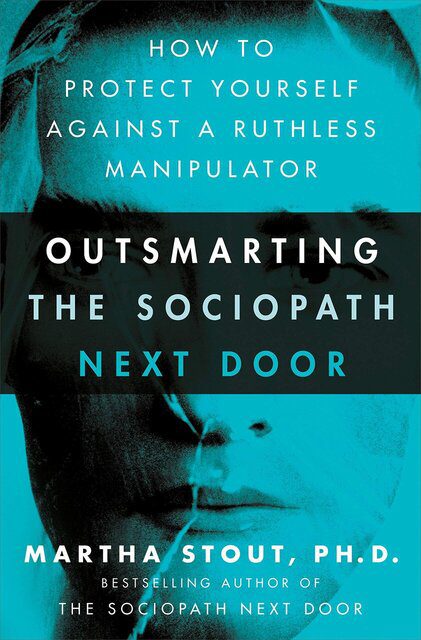In The Sociopath Next Door, Dr. Martha Stout highlighted various ways of identifying a sociopath and Thirteen Rules for Dealing with Sociopaths in Everyday Life. In Outsmarting the Sociopath Next Door, She uncovers the psychology behind the sociopath’s methods and provides concrete guidelines to help navigate these dangerous interactions.
Sociopaths are human beings who look like everyone else—so well camouflaged that their true nature may have gone unrecognized for years or even decades.
Favourite Take-aways
Evil behavior emanates from an emotional hole, and being unaware of this has severely limited our ability to deal with ruthlessness in our day-to-day lives and in our society.
Personality Awareness
We must learn that, despite their trademark lack of emotion, sociopaths are “emotion-eaters.” They have an intense desire to witness their control over us by inciting our confusion, anger, and fear. They feed off the negative emotions of others. Knowing when and how not to display emotion—how to remain calm in the presence of a sociopath rather than feeding him with our immediate feelings—is a vital skill.
“The hardest thing to hide is something that is not there.”—ERIC HOFFER
Wickedness is not an invasive spirit or thing, nor is it some shadowy part of the primal human brain. It is the opposite: rather than an entity that we could observe or at least feel, evil is an absence. Instead of something, it is a hollowness where something should have been. True evil is an empty hole, nothing more—and nothing less.
Conscience
The warm feelings that are part of normal human bonding (love of family and friends, caring, affection, gratitude) are the basis of what we call conscience; without them, conscience cannot be. Conscience is ever-present in the lives of people who are emotionally whole.
Sociopath Defined
According to a newer (2013) version of the manual (DSM-5), antisocial personality disorder is “characterized by a pervasive pattern of poor social conformity, deceitfulness, impulsivity, criminality, and lack of remorse” and is diagnosable when three or more of the following seven “pathological personality traits” are present:
- Manipulativeness: Frequent use of subterfuge to influence or control others; use of seduction, charm, glibness, or ingratiation to achieve one’s ends.”
- Deceitfulness: Dishonesty and fraudulence; misrepresentation of self; embellishment or fabrication when relating events.
- Callousness: Lack of concern for feelings or problems of others; lack of guilt or remorse about the negative or harmful effects of one’s actions on others; aggression; sadism.
- Hostility: Persistent or frequent angry feelings; anger or irritability in response to minor slights and insults; mean, nasty, or vengeful behavior.
- Irresponsibility: Disregard for—and failure to honor—financial and other obligations or commitments; lack of respect for—and lack of follow-through on—agreements and promises.
- Impulsivity: Acting on the spur of the moment in response to immediate stimuli; acting on a momentary basis without a plan or consideration of outcomes; dificulty establishing and following plans.
- Risk-taking: Engagement in dangerous, risky, and potentially self-damaging activities, unnecessarily and without regard for consequences; boredom proneness and thoughtless initiation of activities to counter boredom; lack of concern for one’s limitations and denial of the reality of personal danger.
Isopraxism
Isopraxism, or reflexive mirroring, means duplicating another’s body language, gestures, vocal tone, accent, word and metaphor choice, facial expression, and even breathing rate. It often occurs automatically between close friends, lovers, and people who are flirting. Usually unnoticed by either party, isopraxism tends to deepen a sense of trust and emotional closeness between two people in a healthy relationship.
Unfortunately, to beguile and maneuver a victim into a distinctly unhealthy liaison, the sociopath can consciously employ such trust-inducing behaviors—all the while supplying hyperbolic flattery and appearing to be fascinated by the victim’s interests and concerns.
Crocodile tears
When challenged on his or her manipulative and callous behavior—and, in some cases, actual lawbreaking—the sociopath is adept at producing crocodile tears and playing the part of the wounded or vulnerable party.
The Pity Play
A behavior meant to exploit the normal person’s tendency to feel sympathy and compassion—is often the only sign of sociopathy that is visible to the untrained eye. This usually happens after the sociopath has been discovered in some particularly egregious act and repeated claims of innocence have not been effective. Suddenly, the sociopath alleges that he or she is hurt, deeply depressed, dramatically remorseful, or physically ill.
The Game
After the sociopath has been found out, a typical sequence of ploys is threefold:
- protestations of innocence – “Why would I do such a thing?”
- pity play – “I’ve been feeling suicidal lately, and these accusations are going to push me over the edge!”)”
- Rage – finally, if neither denying the truth nor the pity play has succeeded in closing the issue, a stunning and seemingly incongruous display of rage that includes threatening the accuser with harm if she or he persists.
Just like everyone
Their faces are not frightening or evil-looking; nor do sociopaths appear to be insane. They do not hide in dark corners, or speak in menacing voices, or foam at the mouth. Most sociopaths look and sound just like us. They vary widely in degree of education, intelligence, and talent, just as we do. They are to be found in minimum-wage jobs as well as in high-powered professional and political careers, and in all the many stations in between.
They are welfare recipients and welfare policymakers, factory workers and factory owners, students, teachers, artists, doctors, lawyers, CEOs, and any other sort of person one might conceivably encounter in our society. They look like us, appear to have lives just like ours, and the great majority of them will never be chased by the police, tried in court, or thrown into prison.
On average, only about 20 percent of prison inmates in the United States are sociopaths.
Kazdin Method
The best way to eliminate an unwanted behavior is to build a strong alternative behavior in its place, what’s called the positive opposite of the unwanted behavior. The Kazdin Method® provides step-by-step instruction in how to do this under almost any conditions without throwing rewards at your child.
COMPETITIVE BEHAVIOR
One of the surprising giveaways of sociopathic behavior is that often it is not self-promoting in the usual sense. Typically, the sociopath “competes”—violently, verbally, sexually, or in some other way—for the exclusive purposes of diminishing and controlling others, such that sociopathic competition looks less like vying with another person for resources and advancement (normal behavior in many work settings) and more like tormenting and attempting to damage another person just for fun (distinctly abnormal and disruptive behavior in any work setting).
Vulnerability
To initiate a sociopathic pattern, the ruthless may pick the especially vulnerable, because, as we have just seen, this is horrifyingly easy. Sociopaths who have more power and resources themselves often will take aim at more challenging targets—individuals who are extremely accomplished in their careers—apparently because such people inspire envy and also because they supply greater sport.
The American Medical Association estimates that as many as 75 percent of sociopaths are dependent on alcohol, and 50 percent abuse other drugs.
Sociopaths who turn to lethal violence are in the minority. Most conscienceless people are destructive liars and manipulators who play brutal psychological, financial, and political games with our lives, and they comprise the single largest group of domestic abusers—which is to say, people who attempt to enhance their sense of power and control by beating up on spouses, children, and the elderly—but they are not often murderers. However, when they are, the results are severely disturbing.
No face of Evil
We want our monsters to look like monsters. That we should want this makes good sense: if everyone who did hideous things looked like a person who did hideous things, we would know for sure that we were safe when we encountered people who looked like regular folks. But there is no face of evil.
Pamela Smart, who conspired with friends to kill her husband, had been a cheerleader in high school. Notorious serial killer Ted Bundy was so handsome and charismatic that women sent marriage proposals to him on death row. The Parkland, Florida, school shooter, Nikolas Cruz, while in prison, has received romantic, sympathetic notes from girls.
“We tend to conjure entirely the wrong images when we try to keep ourselves safe from those who commit horrors. Assaultive and violent sociopaths, though a small minority, constitute a compelling reason to raise our awareness of the sociopathic pattern.”
The absence of conscience—whether it be called sociopathy or psychopathy—is the psychological disconnection from the common well of human caring. Such detachment leaves only the desire to diminish and dominate one’s fellows, the ultimate expression of which is killing them.
Battered spouse syndrome
Battered spouse syndrome, a psychologically crippling reaction to repeated trauma. The assaulted spouse becomes so shell-shocked that she is terrified of leaving. An especially paralyzing aspect of battered spouse syndrome is that the abused spouse comes to believe she has brought her plight on herself—that she somehow deserves the abuser’s brutal behavior—and that therefore she does not deserve to escape.
Cyber Assault
For the first time in human history, we can torment and victimize someone without direct contact. Cyberassault is not thought of as murder—although it has certainly led to suicides. It is a modern version of consciencelessness that relieves the assaulter of bloody hands. Done from a distance, sometimes anonymously, it gives the sociopath the same glee, the same happiness that he’s ruining someone’s life, as direct assault and victimization.
Computer science and other technologies advance so quickly that often we are not able to keep up with them emotionally, morally, or even legally. Our furiously changing circumstances have conferred myriad blessings of creativity and communication—and, frighteningly, they have accidentally provided new and almost completely unregulated playing fields for the conscienceless.
Certain activities on these playing fields demonstrate that destroying a life can be done without even touching the victim and without any of the traditional weapons: no guns, no knives—just soul-crushing words and images on electronic screens. Among the most heartbreaking illustrations of the sociopath’s coldness of heart are accounts of cyberbullying by adolescents and young adults. In cyberspace, efforts at deceit and predation are limited only by the imagination of the perpetrator.
Ten Key Guidelines
The best way to deal with a sociopath is to avoid him or her, to refuse any kind of contact or communication. The only completely effective way to protect yourself is to disallow him or her from your life altogether. Sociopaths live wholly outside of the social contract, and, violent or not, they are always destructive. But, unfortunately, it is not always possible to avoid the sociopath, even after he or she has been identified.
TEN KEY GUIDELINES WHEN YOU MUST FIGHT A SOCIOPATH
- GUIDELINE #1: UNDERSTAND THE PERSON YOU ARE DEALING WITH
- GUIDELINE #2: UNDERSTAND THAT YOU ARE ON THE SIDE OF GOOD; ENVISION A MISSION.
- GUIDELINE #3: CHANGE THE GAME.
- GUIDELINE #4: FOCUS CLEARLY ON YOUR OWN GOAL.
- GUIDELINE #5: DO NOT GIVE THE SOCIOPATH WHAT HE OR SHE WANTS.
- GUIDELINE #6: ENLIST OTHERS.
- GUIDELINE #7: UNDERSTAND THAT THIS MISSION IS ONLY ONE PART OF YOUR LIFE RIGHT NOW.
- GUIDELINE #8: DO NOT CATASTROPHIZE.
- GUIDELINE #9: TAKE CARE OF YOUR HEALTH.
- GUIDELINE #10: PROTECT YOURSELF FROM VIOLENCE.
The sociopath is winning each time you do any of the following:
- Fail to understand his true nature
- Play by his rules
- Lose sight of your real goals
- Let him see your anger, your confusion, or your hurt
- Remain isolated and attempt to go it alone
- Spend all your time and energy dealing with or thinking about him
- Lose your balance and set impossibly huge tasks for yourself
- Lose your patience (which is a virture you are developing)
- Allow yourself to panic or catastrophize (imagine outcomes far worse than any that are likely)
- Allow yourself to remain so stressed that your functioning is affected or you get sick altogether
- Lose your guiding sense of the meaning, history, and shared experience of what you are doing (your “mission”)
Looked at the other way around, you are winning each time you do any of the following:
- Remind yourself of the objective information you have learned about sociopaths
- Reflect on the fact that your conflict with this ruthless individual is part of a much larger and older contest between human connection and hollowness
- Change the game on the sociopath (redefine what it means to win)
- Focus on your own goal instead of his
- Shield your emotions from the sociopath
- Strengthen ties with people who do possess conscience and empathy
- Divide your mission into doable steps
- Pace yourself
- Remain rational and pragmatic
- Attend to your health by practicing a stress-reduction technique
“In general, the narcissist delights in being singled out; the sociopath wishes to blend in.”
sociopathy vs narcissism
Where the sociopath is devoid of both conscience and empathy, the narcissist lacks “only” empathy. In other words, the sociopath can neither form feelings of connection with others nor directly perceive their emotions, whereas the narcissist cannot perceive the emotions of others but can, in his way, form interpersonal bonds. Because he has the capacity to bond, the narcissist does experience the emotion of conscience. But his ability to act on that conscience is severely flawed by his impenetrable ignorance of other people’s feelings and needs.
Healthy vs Malignant Narcissism
All of us need a certain amount of normal self-regard (“healthy narcissism”) to develop normally and thrive in adult life, but when that feeling grows out of proportion and overwhelms other feelings, we come to suffer from narcissism.
When narcissism grows so large that it hurts relationships and other people, some professionals call it pathological or pernicious or malignant narcissism. When a person is referred to as simply narcissistic, the usual implication is that his relationships and the people in his life are being harmed and that the word pathological would apply.
Narcissistic Injury and Rage
When another person, or the world at large, comes across with criticism or a reality concern, he experiences what psychoanalysts refer to as a “narcissistic injury”—a psychological threat to his fragile but all-important inner world. Typically, the narcissist will respond to such an affront, even a seemingly slight one, with a primal rage—a seemingly inexplicable white-hot fury that initially feels frightening to other people.
“Sociopaths always do what is best for themselves without considering others, because they have no conscience. Narcissists always do what is best for them because, in their minds, what is best for them is best for the world.”
THE CHILL FACTOR AND THE PITY PLAY
Sociopathy is all about the thrill of coldly “playing” with people the way a predator plays with its prey. A narcissist unintentionally damages other people’s lives, often severely, but he or she is not a coldly calculating predator who torments people for the fun of it. A narcissist is not ice-cold. A sociopath is.
Sociopaths are far more skilled than narcissists—or anyone else—in the art of the “pity play.” The narcissist may be hypochondriacal (actually believing she or he has nonexistent medical problems), but seldom engages in intentional pity plays. Indeed, narcissists, with their need to feel superior, are strongly opposed to appearing pitiful.
Learning about sociopathy encourages an understanding that evil is not a being or a force, but rather a tragic deficiency—an absence that sometimes occurs in the human brain and psyche—and that those afflicted with this deficiency do not all reside out there somewhere, but right here among us as well.
Robert Hare’s Psychopathy Checklist
Robert Hare’s Psychopathy Checklist is a diagnostic tool and highly regarded research aid that in recent years has been adopted eagerly by the criminal justice system, primarily to assess the likelihood of future violence in individual criminals and the possibility (or not) of rehabilitation. The twenty items on the PCL-R assess lifestyle and criminal behavior and characteristics such as glib and superficial charm, grandiosity, need for stimulation, pathological lying, conning and manipulating, lack of remorse, callousness, poor behavioral controls, impulsivity, irresponsibility, and failure to accept responsibility for one’s own actions.
Each of the items is scored on a three-point scale (0, 1, 2), according to specific criteria that are evaluated using a semi-structured interview, the individual’s file, and collateral information. The checklist has a maximum total score of 40, and conventionally a score of 30 or more is thought to identify a “psychopath,” for whom the likelihood of rehabilitation is slim.
Forgiving vs Forgiving
“forgiving is not at all the same as forgetting.”
Forgiving can liberate you. In contrast, simply forgetting what you have learned about someone through painful experience is naive, dangerous, and unnecessary. Sometimes compassion and forgiving are better done from a distance, and there is nothing psychologically or spiritually wrong with being rational and using the information you have gathered about a ruthless person to protect yourself and the other people in your life.
To forgive is not to forget. Indeed, forgiving something that is mostly forgotten is not real forgiveness.



2 Comments
Pingback: On Sociopathy. – Lanre Dahunsi
Pingback: Dr. Martha Stout on Sociopathy. – Lanre Dahunsi